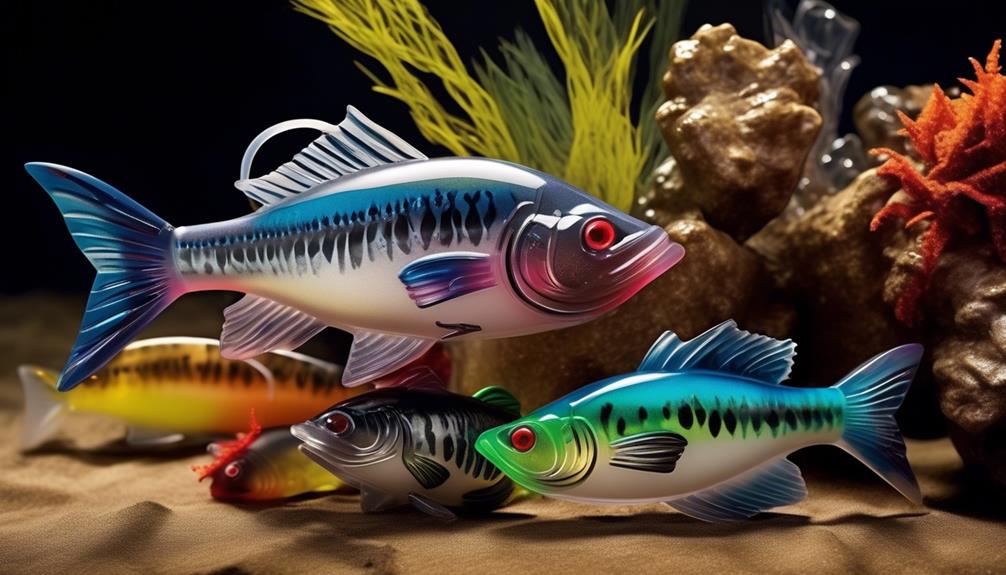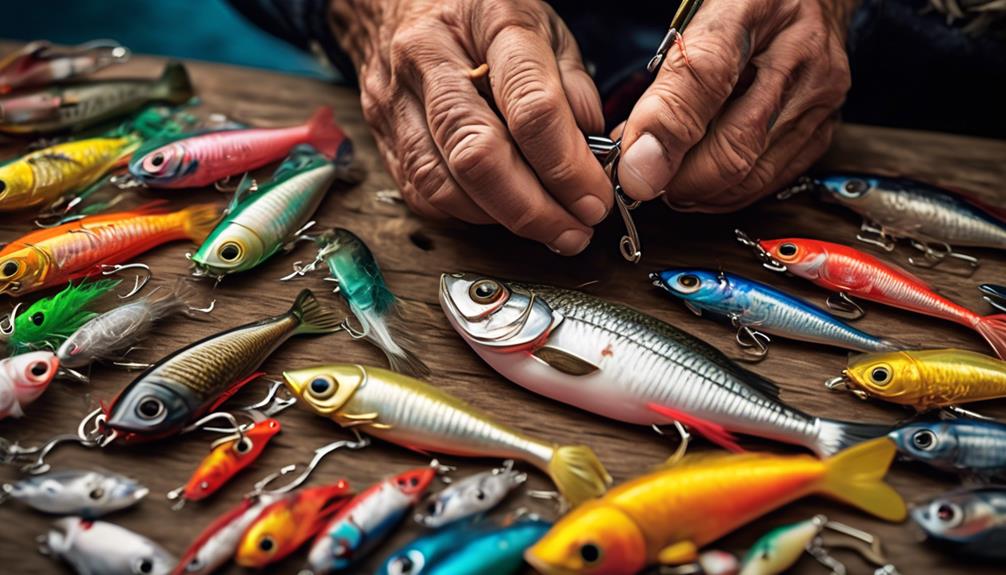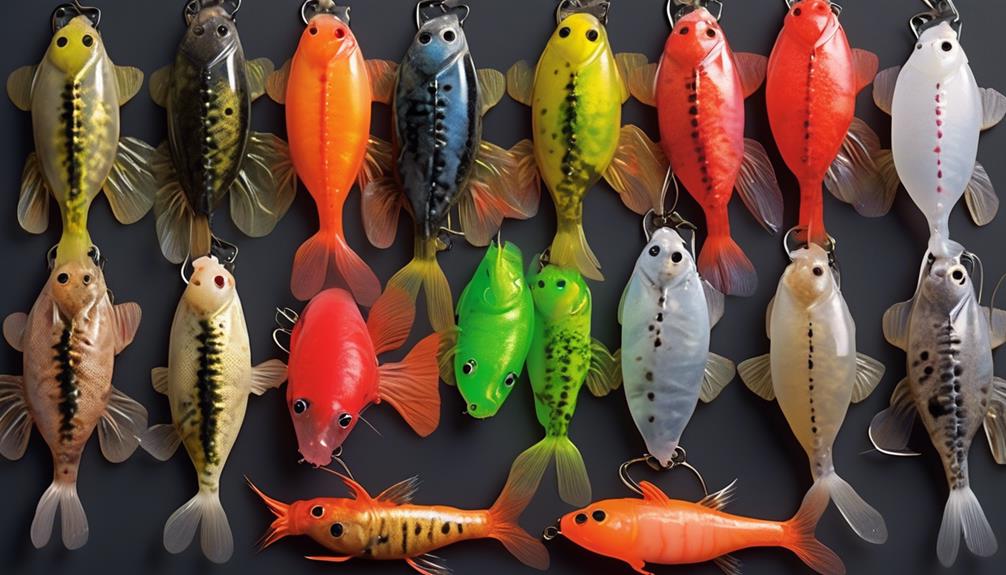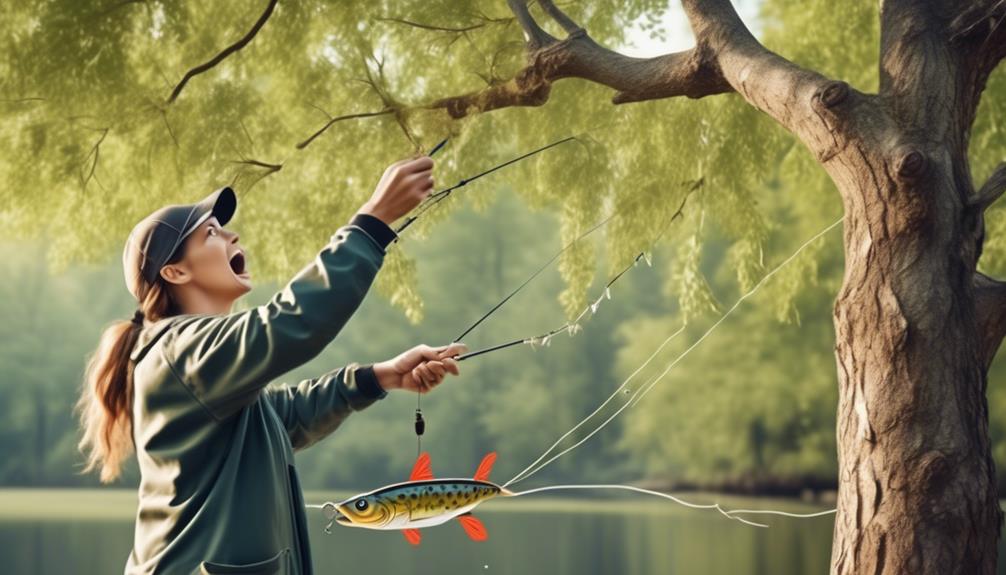Imagine yourself out on the open sea, the waves gently rocking the boat as you set out to reel in the ultimate catch. Just like a skilled painter selects the perfect brush for a masterpiece, choosing the right lure for deep-sea fishing can make all the difference in your success.
As you stand at the helm, staring out into the deep blue, you might wonder which lures will entice the biggest, most elusive fish to bite. Well, look no further, because we've got the inside scoop on the five top-notch lures that will elevate your deep-sea fishing game to the next level.
Diamond Jigs
Diamond jigs are essential deep-sea fishing lures known for their versatility and effectiveness in attracting a wide range of saltwater species.
When it comes to jigging techniques, diamond jigs are incredibly versatile. You can use a variety of retrieval methods, including a rapid vertical jigging motion to entice aggressive species like kingfish and amberjack, or a slower, more deliberate jigging action to target bottom-dwelling species such as grouper and snapper. Varying your jigging technique can make a significant difference in enticing bites from different species.
Lure color selection is another crucial aspect of using diamond jigs effectively. Different colors can attract fish in varying water and light conditions. For bright, sunny days, metallic finishes like chrome or silver can effectively reflect light and attract the attention of pelagic species like mackerel and tuna. On overcast days or in murkier waters, using darker-colored jigs such as blue, black, or purple can create a more visible silhouette, making them more appealing to predatory species like striped bass and bluefish.
Understanding jigging techniques and selecting the right lure colors can greatly enhance your success when using diamond jigs for deep-sea fishing. By adapting your jigging style and choosing the appropriate colors based on the conditions, you can maximize your chances of enticing a wide variety of saltwater species to strike your lure.
Vertical Jigs
When targeting a variety of saltwater species, mastering the technique of vertical jigging can significantly enhance your deep-sea fishing success. The method involves dropping a heavy metal jig vertically into the water column and then jerking it upwards to entice fish to strike. Vertical jigging is highly effective in deep sea habitats where fish often suspend at various depths, making it an ideal technique for catching species such as amberjack, snapper, and grouper.
- Jigging Techniques
- Vary the jigging motion: Experiment with different jerking patterns and speeds to mimic injured prey, attracting the attention of predatory fish.
- Pay attention to the line: Keep the line taut and be ready to set the hook as soon as you feel a strike.
- Vertical Jigging and Fish Behavior
- Understanding fish depth: Use a fishfinder to locate the depth at which the fish are suspended, allowing you to target them effectively.
- Mimicking natural movements: Vertical jigs can imitate the erratic movements of wounded baitfish, triggering a predatory response from deep-dwelling fish.
Deep Diving Plugs
Deep diving plugs are essential tools for reaching and enticing deep-sea game fish, allowing you to target species that dwell at significant depths. These lures are designed to dive deep into the water, mimicking the movement of injured baitfish, which is irresistible to predatory fish. When choosing deep diving plugs, pay attention to the lure action and depth control for a successful deep-sea fishing experience.
Lure action is a crucial factor to consider when using deep diving plugs. These lures are built to create a realistic swimming motion, resembling that of a distressed baitfish. The back-and-forth movement, combined with the wobble and vibration, effectively attracts the attention of deep-sea predators. Look for deep diving plugs with a tight wobble and erratic action to imitate the behavior of injured prey, increasing the likelihood of enticing a strike from game fish lurking in the depths.
Moreover, depth control is vital for effectively targeting deep-sea species. Deep diving plugs are engineered to achieve specific depths, allowing you to reach the vertical range where predatory fish are active. By controlling the diving depth of the lure, you can precisely present it within the strike zone of deep-sea game fish, maximizing your chances of a successful catch. Consider factors such as the diving lip size and shape, as well as the sinking rate, to ensure that your deep diving plugs can reach and maintain the desired depth during retrieval.
Mastering lure action and depth control with deep diving plugs will undoubtedly elevate your deep-sea fishing game.
Squid Skirts
To effectively target deep-sea species, consider adding squid skirts to your fishing arsenal, as they provide a versatile and enticing option for attracting game fish in the depths. Squid skirt design plays a crucial role in their effectiveness. Here are some important design aspects to consider:
- Skirt Length:
- Shorter skirts work well for high-speed trolling, while longer skirts are better suited for slower trolling speeds or jigging.
- Skirt Material:
- Soft, lifelike materials such as silicone or PVC are preferred for their natural movement in the water, which can be especially enticing to deep-sea predators.
When selecting squid skirt colors, it's essential to take into account the varying light conditions at different depths and the prey typically available to the target species. Here are some key considerations for squid skirt color selection:
- Water Clarity:
- In clearer water, natural colors like blue, green, and clear skirts tend to be more effective, whereas in murky water, brighter colors like pink, orange, and chartreuse can stand out better.
- Prey Imitation:
- Matching the color of the squid skirt to the prevalent prey in the area can increase its attractiveness to game fish, as it mimics familiar food sources.
Bucktail Jigs
Consider incorporating bucktail jigs into your deep-sea fishing gear for their versatility and effectiveness in attracting a variety of game fish species. Bucktail jigs are a must-have in your tackle box when venturing into deep sea fishing locations, as they're known for their ability to mimic the movement of injured baitfish, making them irresistible to predatory species. When using bucktail jigs, mastering jigging techniques is key. Varying your retrieval speed and incorporating sudden jerking motions can simulate the erratic movements of distressed baitfish, enticing strikes from various game fish.
When selecting the right bait for your bucktail jig, consider the seasonal patterns of the target species. In spring and summer, when baitfish are abundant, using natural-colored bucktail jigs can yield great results. During fall and winter, when game fish are feeding on different bait species, opting for jigs in darker or more vibrant colors can be more effective. Understanding the preferences of the local game fish and their feeding habits is crucial for bait selection.
Whether you're targeting bottom-dwelling species like grouper and snapper or pelagic species such as tuna and mahi-mahi, bucktail jigs are a go-to lure for deep-sea fishing. Their adaptability to various jigging techniques and bait selections makes them an essential tool for anglers looking to reel in a diverse range of game fish species in different deep-sea fishing locations and seasonal patterns.
Trolling Lures
When selecting trolling lures for deep-sea fishing, focus on choosing versatile options that can attract a wide range of game fish species. Trolling lures are essential for covering a large area of water and enticing predatory fish to strike. To maximize your success with trolling lures, consider the following key factors:
- Trolling Techniques and Bait Selection
- Vary your trolling speed to determine the most effective lure action. Experiment with high-speed trolling for species like wahoo and tuna, or slow trolling for marlin and sailfish.
- Opt for lures that mimic the natural prey of the target species. For example, use squid or flying fish imitations for mahi-mahi and marlin, while large spoons or plugs can attract kingfish and barracuda.
- Trolling Depth and Line Setup
- Use diving planers or downriggers to control the depth at which your lures are presented. This allows you to target specific depth ranges where game fish are most active.
- Consider using wire or monofilament leaders to mitigate the risk of cutoffs from toothy predators such as wahoo or king mackerel.
Soft Plastic Swimbaits

Soft plastic swimbaits offer a versatile and effective option for targeting a variety of game fish species in deep-sea fishing. These lures have several advantages.
They come in a wide range of sizes, shapes, and colors, allowing you to mimic different types of prey. This versatility makes them suitable for various fishing conditions.
Soft plastic swimbaits also have a lifelike swimming action, which can attract predatory fish and trigger strikes. Additionally, their soft texture can result in better hook sets, increasing the chances of landing a catch.
However, there are some disadvantages to consider. Soft plastic swimbaits can be more fragile than other types of lures, leading to potential damage from aggressive strikes or encounters with sharp-toothed fish. Moreover, they may require more frequent replacement, adding to the overall cost of fishing.
To make the most of soft plastic swimbaits, consider the best techniques and tips for using them. When fishing in deep-sea environments, it's important to match the swimbait size to the prevalent forage. Larger baits are ideal for targeting bigger species, while smaller ones are suitable for smaller fish.
Vary your retrieval speed and experiment with different depths to find where the fish are congregating. Additionally, try using different rigging options such as weighted hooks or jig heads to adapt to changing conditions.
Metal Speed Jigs
Metal speed jigs offer an enticing and rapid descent through the water column, making them a powerful choice for attracting deep-sea game fish. When using these lures, it's essential to understand the jigging techniques and underwater action that can maximize their effectiveness.
Here are some key points to consider:
- Jigging Techniques
- *Jerking Motion*: Utilize a sharp, upward jerking motion with your rod to create an erratic and fluttering action that mimics an injured baitfish, attracting the attention of predatory fish.
- *Pause and Fall*: After the upward jerk, allow the speed jig to pause and fall back down, simulating a wounded prey's erratic movements, enticing strikes from nearby game fish.
- Weight Distribution and Hook Placement
- *Center of Gravity*: The weight distribution in metal speed jigs is designed to create a rapid vertical descent, imitating a fleeing baitfish. Understanding the center of gravity can help you control the lure's action more effectively.
- *Assessing Hook Placement*: Ensure that the hooks are properly positioned to maximize hookup ratios. Check for any tangles or obstructions that could impede the lure's action or the hook's ability to set properly.
Mastering these techniques and understanding the intricate design features of metal speed jigs will greatly enhance your deep-sea fishing experience. So, next time you're out on the open water, remember these tips to make the most of your metal speed jig and entice those elusive game fish lurking in the depths.
Frequently Asked Questions
What Are the Best Times of Day or Year to Use Each Type of Lure for Deep-Sea Fishing?
When deep-sea fishing, the best times to use each type of lure depend on the conditions. Different lures are effective at various times of the day or year.
Understanding the behavior of the fish and the lure techniques is key. Experimenting and adjusting your approach based on the deep sea fishing conditions can maximize your chances of success.
Keep an eye on the water temperature, weather patterns, and the movement of the fish for optimal lure usage.
Are There Any Specific Techniques or Tips for Using These Lures in Different Weather Conditions or Water Depths?
When it comes to deep-sea fishing, weather conditions play a big role in lure selection. In rough seas, opt for heavier lures to prevent them from getting lost in the waves. For calm waters, lighter lures work best for attracting fish.
Adjusting your retrieval speed and depth based on water currents and depth is crucial. In deeper waters, consider using lures with rattles or bright colors to grab the attention of fish lurking in the depths.
Can These Lures Be Used for Targeting Specific Types of Deep-Sea Fish, and if So, What Are the Best Ways to Do So?
To target marlin and tuna, use live bait and trolling techniques. Live bait can attract these fish by mimicking natural prey, while trolling allows you to cover more ground and increase your chances of a strike. When using these lures, adjust the trolling speed to match the preferred swimming speed of the targeted fish.
Vary the depth at which the lures are presented to effectively target specific types of deep-sea fish.
Are There Any Special Considerations for Maintaining and Storing These Lures to Ensure Their Longevity and Effectiveness?
To maintain and store your lures for longevity and effectiveness, follow these steps:
- Keep them clean and dry after use.
- Rinse them with fresh water and let them air dry completely.
- Store them in a cool, dry place away from direct sunlight to prevent deterioration.
- Consider using lure wraps or boxes to prevent tangling and damage.
- Regularly inspect and replace any worn or damaged parts to ensure optimal performance on your next deep-sea fishing adventure.
How Do the Materials and Construction of Each Type of Lure Affect Their Performance in Deep-Sea Fishing Scenarios?
When fishing deep-sea, materials and durability directly impact lure performance. Different depths require specific features for success.
Materials like stainless steel and durable plastics are ideal for deep-sea lures, as they withstand harsh conditions. Construction affects how lures move in water, attracting fish.
Consider lures with strong hooks and reinforced connections for deep-sea fishing. By prioritizing materials and construction, you'll boost your chances of reeling in a big catch.
Conclusion
So there you have it, five top-notch lures for successful deep-sea fishing.
With diamond jigs, vertical jigs, deep diving plugs, squid skirts, and bucktail jigs in your tackle box, you'll be ready to reel in some big catches on your next deep-sea fishing adventure.
So grab your gear, hit the open water, and get ready to experience the thrill of deep-sea fishing with these top-notch lures.
Happy fishing!



